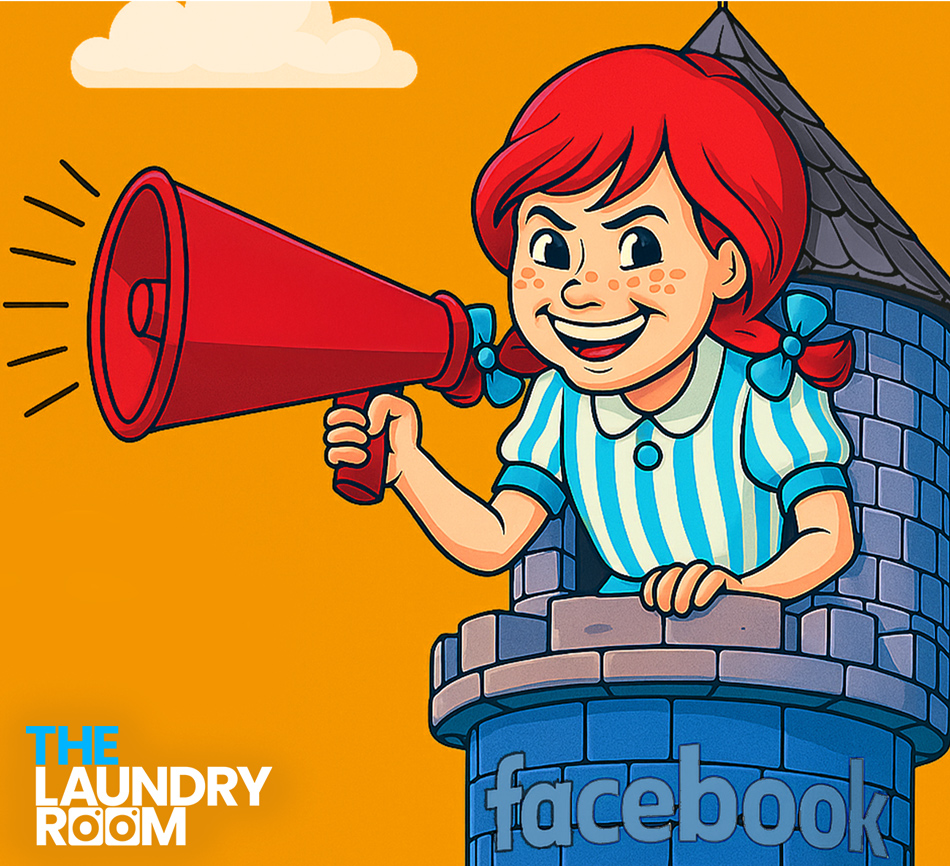Welcome to The Laundry Room. I’m Nick Skislak, sitting with Michael Taylor, Michael Taylor 2. Today we’re going to talk, I’m really excited about this.
We’re talking about timing today. How long do you give it? How long do you give this marketing stuff?
Before you say, heck with it, I’m sticking to my trade shows and my sales team. That’s what we’re talking about today.
Yeah, it’s a touchy subject, man.
00:40 – 01:02
How long should you go? So you’ve never done it or you’ve done it a few times. I think both scenarios, right?
You’ve either never done it before and you’re ready to start. How long do you wait? Or you’ve been burned.
You’ve been burned on this before. You’ve done stuff and it’s not working. You’re going to go try something new.
01:02 – 02:08
How long? How long should you wait? How long should you try?
What should you be looking for to say, is this working or not?
What’s tough for a company that fits that persona is forever, their business has thrived or survived, depending on how you look at it, on sales only. Call it referral biz or just good old fashion.
Pounding the pavement.
Beating the streets, man. And so, when you have a company that is legitimized, is making money, and that’s what has worked for them, to now introduce this concept of marketing or getting in front of an audience that doesn’t require salesperson at the front end of that, or a referred
02:09 – 02:38
already ready client, customer, that’s tough. And so, I think there’s a lot of education, a lot of understanding, acceptance that has to happen for someone in that decision role to say, yes, we should be investing in marketing.
We should be getting in front of people who matter. And that, so overcoming that part to then be teed up for, well, how long should we give it?
02:38 – 03:13
And until you have that education of, well, what is success?
What is, what kind of timelines are we talking about? What should expectations be in those timelines? Then you can maybe have a little more confidence in debating timeline.
I think it’s a year.
Oh, you already got the answer. It’s a year.
I was going to, I was in thinking about this.
03:13 – 03:37
I was going to say a year and a half, 18 months. But realistically, I think you should do it.
It should be a year. And I know, like, you know, it’s common for agencies to do month to month and, you know, do these kind of nine month engagements and we’re going to do this and that. And, you know, that can be successful,
03:37 – 03:56
to be fair.
Those can be successful. But if you really want to integrate, if you really want to make marketing a part of your organization to grow your business, you need a year to figure out what the heck’s going on.
Define marketing for me then, because I think some, a lot of people would say, we’re doing marketing, man.
03:56 – 04:28
I have a marketing guy, marketing gal.
Attribution is way off, though. I mean, those aren’t really marketing people. Marketing is the activities that you do to introduce, engage, nurture, and build trust with your target prospect audience.
And what I see a lot with internal teams is you have internal marketing people that are supporting existing client relationships, or supporting referral leads from sales guys.
04:28 – 04:56
Sales enablement.
Sales enablement teams. I rarely see, rarely see in-house marketing teams that are actually doing what I define as marketing, which is, and I guess I’ll take it a step further and say growth marketing. Because there are, there is a value.
I won’t argue that. There is a value for you to continue to keep top of mind for your existing clients.
04:56 – 05:19
There are communications that businesses have to have with their clients on an ongoing basis.
I totally agree with that. That is true. The problem is, for most companies, that’s like 80% of their marketing budget goes to those efforts.
I mean, this is what I hear, and I won’t say all the time, but most of the time I hear about these insane trade show budgets,
05:19 – 05:50
it’s because so-and-so is going to be there. And so-and-so is already an account. So, and again, I’m not saying they shouldn’t be there.
But when we’re talking about growth marketing, activities that are going to add new clients, new prospects to your circle, there’s a short fuse on it. There’s very little of it being done. And I think it makes it hard to go a year to really test it out.
05:50 – 06:20
So growth marketing for net new clients, net new business. You know, there’s a ton of subsets of marketing. You have what you just described, that account-based marketing where, yeah, we have an account.
We believe there’s more opportunity in there, so we got to be at the trade show. Give me some context around a 12-month time period. What in 12 months is going to be proved or disproved?
06:20 – 06:48
Just traction and benchmarking, I think. Like the only thing that you can really do from a year of, like if you’re first year and you haven’t done this stuff before, and when I say this stuff, I mean paying money to drive traffic to your web property in an effort to engage that audience and make them take some sort of action. Phone call, download, contact form, whatever.
06:49 – 07:20
If you don’t, if you’ve never done that before, you don’t really know what a good month or a bad month is. And most businesses are seasonal in some capacity. So you run it in primed season or not primed season.
Like those are all variables that you are trying to gauge in a 90 day period, whether it’s working or not. With most companies with these sales cycles, and I’ll speak more sophisticated customer journeys, high lifetime customer values, business to business type organizations,
07:20 – 07:40
no one’s buying in 90 days. So for you to judge whether marketing’s working or not in 90 days is not a good move.
This was one of the videos that we want to redo. We talked about this. Hey, do you go with an agency that makes you lock in for a year?
Or do you want to go with an agency that goes month to month?
07:40 – 07:59
Well, most people would probably answer month to month. If they’re not proving it and this isn’t working, then I want to be able to quit immediately.
Well, that feels good for the client, but it certainly doesn’t incentivize the agency to look at your business from a long-term perspective.
07:59 – 08:24
If I’m on month to month with you, am I going to go an extra mile to make this better, to make this bigger, to think about your business in 24 or 36 months from now? Probably not.
So getting on a longer-term engagement, like really understanding what are you willing to invest to do what? And there’s the second part.
08:24 – 08:47
Most guys that come in don’t really have a goal.
They don’t really know what they want to get out of it. And they don’t know what a cost per acquisition is either. Those are important numbers that all come into timing.
How long does it take to close a piece of biz, we’ll ask. Oh, our sales guys are great. Or, this is the most common.
08:48 -09:19
Oh, sometimes it’s like two weeks. Other times it could be a month. Well, when that’s referral biz, that’s short close time, man.
When it’s independent online buyer, B2B buyer shopping you up against three other competitors, in a pain aware phase, not solution seeking yet, just doing research, those could be months. And that’s the piece that a lot of folks don’t know. They’re not up on that.
09:19 – 09:53
And to be able to put a value to that is really difficult. They want to see closed biz. And if you’re looking for closed biz, but you got a 90 day buying cycle, running a six month campaign probably isn’t the best sample or test to run to see if this is going to be valuable for you.
Give some of the considerations for why 12 months would make sense when trying to put up quantifiable return on marketing.
09:54 – 10:14
Things like acquisition costs, lifetime customer value is one that we talk a lot about with our clients. How long are you keeping a new piece of biz?
For us, if there’s an engagement with us that is, let’s just say six months, let’s say eight months for a simple thing. Client comes and they want to do all these things.
10:14 – 10:39
They want growth marketing.
They’re looking for new clients. They want to grow their business through new client acquisition, and they think marketing is going to help them do that. The first couple months that we work with them, they are not in market.
We’re not running ads. We don’t have new emails going out. We don’t have a new website to send people.
We’re just doing work.
10:39 – 11:07
So there’s three months, call it. There’s three months gone.
So now you got, in our, what do we say, eight month engagement, we have five months left. And that’s where our media is going to start, right? We’re going to start running ads.
We’re going to start driving traffic and trying to get people to take action on our website. Well, the first two months of us running any media for the first time are going to be our worst.
11:07 – 11:40
We’re going to be the worst at it.
Anybody really is. I mean, not just us, but if you’re benchmarking a new audience with your messaging, the first two months that you run it, you’re going to learn a lot of stuff. So, all right, now we’re down to 90 days.
Now we have three months left of this eight-month engagement that we learned a little, a thing or two in the first two months, and we’re going to try to implement those changes in the last 90 days. Now, we’ve been able to do a good job of optimizing in those first two months or those, you know, month,
11:40 – 12:08
what would it be, month four and month five. Now we have month six, seventh and eighth to really show them what we can do.
Well, even during that period, any leads that we generate in month seven and eight probably aren’t going to come to fruition until month nine, ten, eleven, twelve maybe. And with a short-term engagement, it’d be really hard to validate your or not validate. What am I looking for?
12:08 – 12:37
Attribute.
Attribute, your investment to your outcomes unless you had a runway of at least what, six months after you ran it. So I get caught on the year, year and a half because hey, a year is a good enough time for you to say, all right, here’s what I put into it. 80% of my results came in the last, we see this all the time, Mike.
80% of the results come in the last 20% of the timeline.
12:37 – 12:57
So all that work that we did really on month seven and eight, that’s where we start seeing ramp up that snowball effect. And that’s, you know, with SEO, with us getting better at buying ads, with us having a better understanding of what users are doing when they come to your website.
We can learn all that stuff and really start seeing momentum.
12:57 – 13:19
And if you stop at that point, well, this ain’t working. That’s what I think, like that nine month or, oh yeah, we’re going to go try something else.
And it’s an attitude of being interested rather than committed. Sticking to it is what you had said in the last episode of sticking to this. That is so important to seeing success.
13:19 – 13:43
You have to see it through because I think ultimately, I think marketing, I want to say will always work. Like it will always work. The only problem is you have to go through iterations and testing and tweaking to make it work.
So if you’re not willing to put in that 12 month of pain, call it nine month of pain to do that,
13:43 – 14:25
I think you’re rolling, it’s a dice roll for sure.
Yeah, I instantly go to the client side, like how does an internal decision maker get on that bandwagon of committed to investing in marketing? And I think the majority of it is defining success, because I think you’re spot on. And for most people, certainly decision makers who aren’t maybe as savvy or in the weeds of marketing, they define it as closed business.
14:25 – 15:06
How much money, how much new revenue was generated from that thing. And that can’t be the only KPI that you’re looking at. It could be the one that is maybe the most important, but there have to be some other leading indicators, right?
So when I love going to a client, after certainly clients who we’ve had longer than 12 months, and you can show them visitor value, for example, when you can show that, hey, every person that comes to your web property is worth X. And they instantly perk up, like, how do you know that?
15:06 – 15:33
What does that mean?
And I don’t have that in my pocket. I don’t have that on my books. Yes, you do.
And when you can use that as one indicator in whether or not we’re doing well, and then better yet, show that compared to previous time period, now you have one more thing that allows that definition to exist of what is, are we winning?
15:33 – 16:06
Is this working?
And that’s the stinky part about it is 15 years ago, you have a not good landing page and a Google Ads account and 400 bucks.
You were winning.
You were winning. Like low competition. No one else was doing it.
Websites were like kind of a thing, but everybody had someone that they knew do it for them. Like it was you were there and you were winning overnight.
16:06 – 16:29
It’s just not that way anymore.
It’s gone so much more deeper into consumer behavior as to what it takes now to get a conversion is way higher than what it was in 2010. Oh, they showed up on Google. They must be legit.
Like that’s way less common than it was back in the day.
16:29 – 17:03
If you were on that first page, you were getting results immediately. And now it does take a longer approach.
And I think a lot of these guys too are trying to get their money back earlier than they should be. So I would say that the marketing that you do for a nine-month, stick to our eight-month example, and let’s pretend it costs 80 grand, just 10 grand a month for eight months,
17:03 – 17:32
and this is what we’re going to do. They’re looking at the 80-grand time period, eight months, and comparing that with the revenue that they had in that eight-month period, compared to what they did last year, and not taking into account the…
The lead time.
The lead time. Yeah, totally. And in that kind of, and not to mention the thing that we struggle with a lot too is lifetime customer value.
17:32 – 18:01
If you sell something to someone and it costs you $2,000 to sell it to them, that might sound expensive if the product was $2,000. Wait a minute, I got to pay $2,000 to a marketing agency to have them sell a product to me for $2,000? Yeah, because your lifetime customer value is five years.
They’re going to pay you $2,000 a year, every year, for your service.
18:01 – 18:28
So this $2,000 that you made right now, cool. You broke even on your marketing.
You’ve just acquired a new customer, and your lifetime customer value is $2,000 a year for five years. It’s $10,000. All right, now you have something, and that’s a piece that not understanding.
I’m shocked at how often we talk to organizations that don’t really understand what their lifetime customer value is.
This is good, man. We have been having one long conversation for over a decade now.
That’s right.
We’ll put a comma here and continue the conversation.
Thanks, Mike.
Appreciate it, man. See you next time, guys.

















